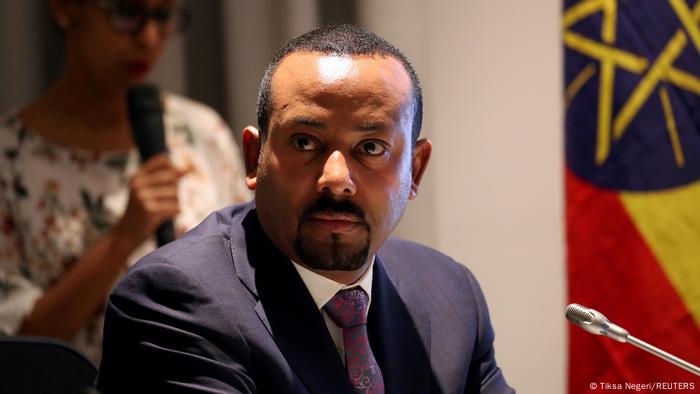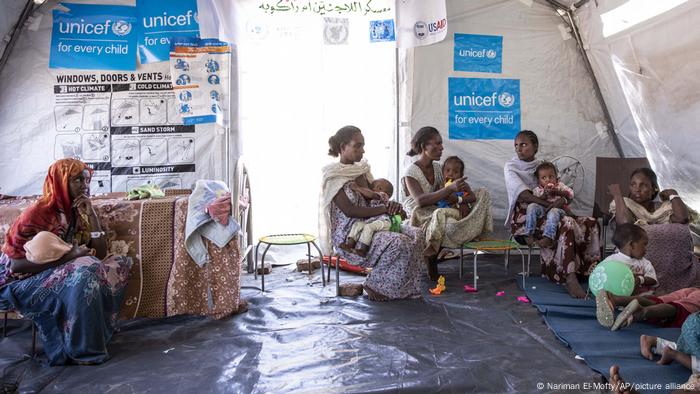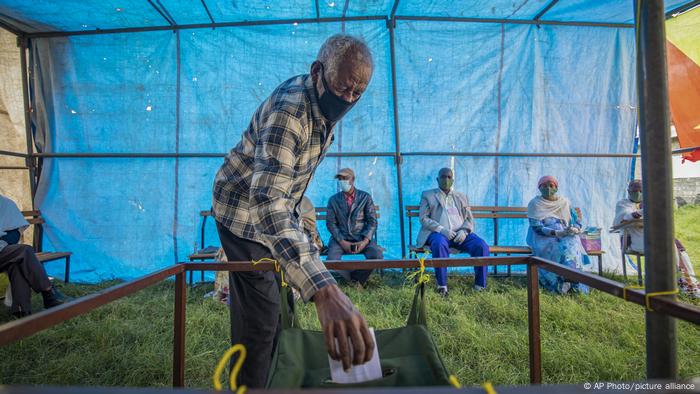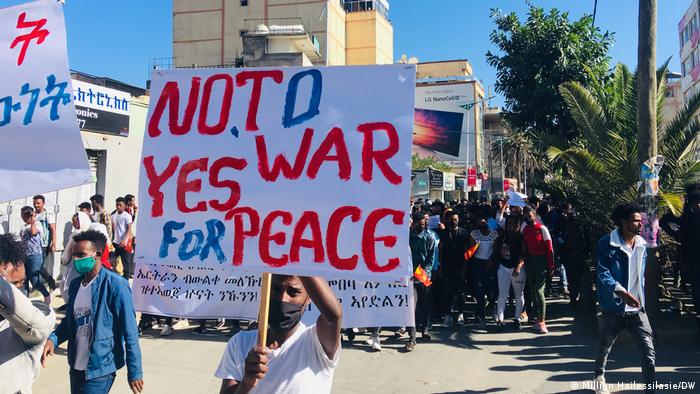
Hate speech in Ethiopia: Abiy Ahmed resurrects old demons

In Ethiopia, a wave of resentment against Tigray is being unleashed on social media, likely galvanized by the government’s anti-TPLF rhetoric. Has Prime Minister Abiy overstepped the mark?
About a month after the start of the conflict in the northern Ethiopian region of Tigray, the propaganda machine is in full gear on both sides.
Daily reports of fighting between the Ethiopian army and fighters of the People’s Liberation Front of Tigray (TPLF) continue to leak, despite Prime Minister Abiy Ahmed announcing several days ago that the fighting was over after government troops marched into the region’s capital, Mekele.
Meanwhile, TPLF-linked media are reporting their own military successes, for example in the historic city of Axsum in the center of Tigray.
Read more: Ethiopia, UN reach agreement for Tigray aid access
Verified information out of Tigray is in short supply due to ongoing communications blackouts. This only makes the battle for the sovereignty of interpretation outside the region even louder.
The overall tone is becoming harsher, too: Abiy recently described the leadership of the renegade TPLF as “criminals” and “hyenas” — terms that are now being rehashed and spread via social media.
On the Facebook page of DW’s Amharic language service, a flood of denigrating comments in the direction of Tigray have been appearing for weeks. Ludger Schadomsky, head of DW Amharic Service, reports a significant spike in problematic and inflammatory postings.
Even if the majority of the comments are directed against the “TPLF junta” or “TPLF mafia,” Tigrayans have also been denigrated as “children of the military junta,” for example, or a people who must be “destroyed and eliminated”. One post mentions the hatred of the “100 million Ethiopians” for “five million Tigrayans.”
Observers say similar comments are coming in on the social media accounts of Ethiopian media houses.
Pent-up anger against TPLF elites?
So, is this an expression of resentment towards the TPLF elites from Tigray, who occupied the most important political, economic and military positions between 1991 and 2018 when Abiy assumed office?
“There is clearly pent-up anger against the Tigrayans over their governance in all the years,” writer and Ethiopia expert Martin Plaut told DW.
Just 6% of Ethiopia’s overall population lives in Tigray. Much of today’s anger is still rooted deeply in the fact that for decades the northern Ethiopian minority claimed a large chunk of the country’s resources for itself.
“Many feel that the TPLF elites are now finally getting the retribution for their actions,” says Plaut.
Read more: Ethiopia: A timeline of the Tigray crisis
Moreover, the prime minister’s office — with its use of harsh language in recent days — has contributed to these feelings of frustration and resentment now coming to the surface, says Annette Weber of the German Institute for International and Security Affairs (SWP).
Nevertheless, Weber cautions against interpreting hate comments on social media as general hostility towards Tigray.
“It is not so much animosity towards Tigray, but rather against the TPLF,” she told DW. “And this is already anchored in the last 30 years of TPLF rule.”
Even anthropologist-historian Jan Abbink from the University of Leiden sees no broad ethnically-driven hostility towards Tigray and its citizens. That people with radical views — some of them within the diaspora — want to influence the mood of the country is regrettable. But, Abbink stresses, the government still makes sure to make a clear distinction between the TPLF and the civilian population.
“The government and state institutions in Ethiopia, but parties in parliament too and activists, are trying with few exceptions to differentiate and defuse such tendencies,” Abbink told DW.
How big is TPLF’s support base?
However, Plaut considers Aby’s anti-TPLF rhetoric to be dangerous.
“I don’t believe one can distinguish so clearly between the TPLF and Tigrayans,” he says. “It just doesn’t work.”
The TPLF only won 90% of the vote in regional elections in September, but that vote is still considered controversial.
“Even if these elections were certainly not the freest and fairest, independent observers on the ground at the time stated that the result more or less reflected the mood in Tigray,” Plaut says.
The TPLF defied the federal government’s postponement of the national polls and held elections of their own on September 9
Read more: ‘Tigray leaders will be held accountable’: Ethiopian minister
Politically, however, Abiy’s communication strategy seems to have worked well so far. The prime minister and his fellow campaigners frequently note that the TPLF has refused offers of talks in the past two-and-a-half years, questioned the legitimacy of the government and undermined domestic security by supporting rebel movements around Ethiopia.
This approach has proved advantageous for the government: At least for the time being, large parts of the country seem to agree on a common enemy — the TPLF — and are less inclined to argue ethic and political differences.
“I was myself surprised that Abiy suddenly acquired so many new supporters,” says anthropologist-historian Abbink. However, he also warns that this wave of support could be short-lived without further reforms.
“The conflicts in other parts of the country, for example on the border between Oromia and the Somali region or between smaller groups in western Oromia, won’t simply disappear,” he explains. “They must be resolved.”
National dialogue on the cards
Weber believes other long-time tensions within Ethiopia will continue to simmer beneath the surface, even if the Tigray crisis drags on.
“This conflict in Tigray has now covered up many other things, but these internal disputes are far from resolved,” she says. “And I believe that without a dialogue that brings a great many people to the table — including young people — who develop a common idea of ‘what kind of state do we actually want to live in?’…Without something like that, it will be difficult to recover.”
A first step towards reconciliation — with Tigray too — could be the elections, which were postponed due to the COVID-19 pandemic and are now scheduled for May or June. But even if the guerrilla warfare in Tigray feared by some experts should fail to materialize, can the wounds of the current conflict heal within just a few months?
“I believe that the government must now make big offers — not necessarily to the TPLF, but to the population,” says Weber. “Offers that show that their interest in elections and in participation are taken seriously.”
“Tigray is an essential part of Ethiopia, historically, religiously, culturally,” says Jan Abbink.
In any case, it is important now that new leadership is established in the region. Despite all the hostilities, there is a deep desire on the part of the central government — and the people of Tigray — for democratic, transparent and productive relations.
This article was adapted from German by Benita van Eyssen.
DW RECOMMENDS
Once enemies, Ethiopia and Eritrea ally against Tigray
Eritrea has been involved in the Tigray crisis in Ethiopia from day one, experts have said. But even though the two countries are fighting together against a common enemy, that does not make them friends.
Source:dw.com
Hate speech in Ethiopia: Abiy Ahmed resurrects old demons

In Ethiopia, a wave of resentment against Tigray is being unleashed on social media, likely galvanized by the government’s anti-TPLF rhetoric. Has Prime Minister Abiy overstepped the mark?
About a month after the start of the conflict in the northern Ethiopian region of Tigray, the propaganda machine is in full gear on both sides.
Daily reports of fighting between the Ethiopian army and fighters of the People’s Liberation Front of Tigray (TPLF) continue to leak, despite Prime Minister Abiy Ahmed announcing several days ago that the fighting was over after government troops marched into the region’s capital, Mekele.
Meanwhile, TPLF-linked media are reporting their own military successes, for example in the historic city of Axsum in the center of Tigray.
Read more: Ethiopia, UN reach agreement for Tigray aid access
Verified information out of Tigray is in short supply due to ongoing communications blackouts. This only makes the battle for the sovereignty of interpretation outside the region even louder.
The overall tone is becoming harsher, too: Abiy recently described the leadership of the renegade TPLF as “criminals” and “hyenas” — terms that are now being rehashed and spread via social media.
On the Facebook page of DW’s Amharic language service, a flood of denigrating comments in the direction of Tigray have been appearing for weeks. Ludger Schadomsky, head of DW Amharic Service, reports a significant spike in problematic and inflammatory postings.
Even if the majority of the comments are directed against the “TPLF junta” or “TPLF mafia,” Tigrayans have also been denigrated as “children of the military junta,” for example, or a people who must be “destroyed and eliminated”. One post mentions the hatred of the “100 million Ethiopians” for “five million Tigrayans.”
Observers say similar comments are coming in on the social media accounts of Ethiopian media houses.
Pent-up anger against TPLF elites?
So, is this an expression of resentment towards the TPLF elites from Tigray, who occupied the most important political, economic and military positions between 1991 and 2018 when Abiy assumed office?
“There is clearly pent-up anger against the Tigrayans over their governance in all the years,” writer and Ethiopia expert Martin Plaut told DW.
Just 6% of Ethiopia’s overall population lives in Tigray. Much of today’s anger is still rooted deeply in the fact that for decades the northern Ethiopian minority claimed a large chunk of the country’s resources for itself.
“Many feel that the TPLF elites are now finally getting the retribution for their actions,” says Plaut.
Read more: Ethiopia: A timeline of the Tigray crisis
Moreover, the prime minister’s office — with its use of harsh language in recent days — has contributed to these feelings of frustration and resentment now coming to the surface, says Annette Weber of the German Institute for International and Security Affairs (SWP).
Nevertheless, Weber cautions against interpreting hate comments on social media as general hostility towards Tigray.
“It is not so much animosity towards Tigray, but rather against the TPLF,” she told DW. “And this is already anchored in the last 30 years of TPLF rule.”
Even anthropologist-historian Jan Abbink from the University of Leiden sees no broad ethnically-driven hostility towards Tigray and its citizens. That people with radical views — some of them within the diaspora — want to influence the mood of the country is regrettable. But, Abbink stresses, the government still makes sure to make a clear distinction between the TPLF and the civilian population.
“The government and state institutions in Ethiopia, but parties in parliament too and activists, are trying with few exceptions to differentiate and defuse such tendencies,” Abbink told DW.
How big is TPLF’s support base?
However, Plaut considers Aby’s anti-TPLF rhetoric to be dangerous.
“I don’t believe one can distinguish so clearly between the TPLF and Tigrayans,” he says. “It just doesn’t work.”
The TPLF only won 90% of the vote in regional elections in September, but that vote is still considered controversial.
“Even if these elections were certainly not the freest and fairest, independent observers on the ground at the time stated that the result more or less reflected the mood in Tigray,” Plaut says.
The TPLF defied the federal government’s postponement of the national polls and held elections of their own on September 9
Read more: ‘Tigray leaders will be held accountable’: Ethiopian minister
Politically, however, Abiy’s communication strategy seems to have worked well so far. The prime minister and his fellow campaigners frequently note that the TPLF has refused offers of talks in the past two-and-a-half years, questioned the legitimacy of the government and undermined domestic security by supporting rebel movements around Ethiopia.
This approach has proved advantageous for the government: At least for the time being, large parts of the country seem to agree on a common enemy — the TPLF — and are less inclined to argue ethic and political differences.
“I was myself surprised that Abiy suddenly acquired so many new supporters,” says anthropologist-historian Abbink. However, he also warns that this wave of support could be short-lived without further reforms.
“The conflicts in other parts of the country, for example on the border between Oromia and the Somali region or between smaller groups in western Oromia, won’t simply disappear,” he explains. “They must be resolved.”
National dialogue on the cards
Weber believes other long-time tensions within Ethiopia will continue to simmer beneath the surface, even if the Tigray crisis drags on.
“This conflict in Tigray has now covered up many other things, but these internal disputes are far from resolved,” she says. “And I believe that without a dialogue that brings a great many people to the table — including young people — who develop a common idea of ‘what kind of state do we actually want to live in?’…Without something like that, it will be difficult to recover.”
A first step towards reconciliation — with Tigray too — could be the elections, which were postponed due to the COVID-19 pandemic and are now scheduled for May or June. But even if the guerrilla warfare in Tigray feared by some experts should fail to materialize, can the wounds of the current conflict heal within just a few months?
“I believe that the government must now make big offers — not necessarily to the TPLF, but to the population,” says Weber. “Offers that show that their interest in elections and in participation are taken seriously.”
“Tigray is an essential part of Ethiopia, historically, religiously, culturally,” says Jan Abbink.
In any case, it is important now that new leadership is established in the region. Despite all the hostilities, there is a deep desire on the part of the central government — and the people of Tigray — for democratic, transparent and productive relations.
This article was adapted from German by Benita van Eyssen.




